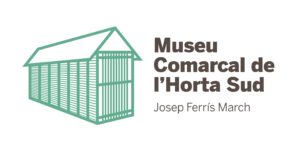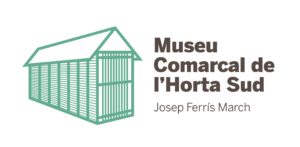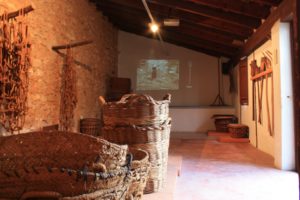The single’s room was a place where the sons or daughters of the family slept. If it was a large family and there was not enough space on the ground floor, new rooms were built upstairs where sons always slept while daughters slept downstairs.
Spaces
THE GROUND FLOOR
B2. The double room
In the double room we can find some typical essentials such as a chest of drawers, a bureau to keep valuables and a sink for personal hygiene – taking into account that these homes did not have bathrooms.
B3. The Dining-room
Apart from the traditional dining-room suite, with various types of chairs and tables, it was furnished with two built-in cupboards to keep expensive china that was only used on especial occasions. The sink in the room was used for hand washing before dining. At first, the fireplace was mainly used as the cooking spot but later it became the essential heating source in order to keep the house warm in winter.
B4. The Kitchen
The kitchen was the place designed for cooking, where samples of different sources of energy used to heat the food are shown: the fire lit on the ground over a “rodeno” (reddish) stone, coal, sawdust, petrol, and also a kind of gas that is still used nowadays. Amongst other utensils that complete the household objects are the kneading table and the sieve, used for the making of the bread. Bread was prepared at home an then taken to the baker’s to be baked. The well was used to provide drinkable water at a time when the water system was not yet set up in this region.
B5. The Stable
The stable was the residing and resting site allocated to the animals used for working the land. Amongst its typical elements, we can find: the manger with forage for the animals, the ornamental tile of St. Antonio Abad, saint patron of the animals, posts to hang the straps and a narrow stairway that communicates with the straw loft upstairs. A latrine can be found in a corner.
B6. The Oil Mill
The oil mill (“almazara”) was the place where olives were turned into olive oil. The procedure started by grinding up the olive in a mill, which consisted of a large stone, turned by a mule. Later the paste left on the ground was collected and then condensed in an iron-pressing machine resulting in juicy-oil. Production was then kept inside large earthen jars made with cooked mud in the Oil Room.
B7. The Oil Room
This was the room where the oil was kept, which served also as a larder where a special cage called “carnera” was kept. This special cage was used to keep meat and sausages away from flies. Other utensils used in food processing were also kept in this room such as boilers, steelyards, funnels, machines used to make sausages and other cold meats, etc.
B8. Patio or Farmyard
Always situated at the back of the house, it was the place where organisation took place: animals to the barn, crops to the top floor, cart to the porch. One could also find in a patio or farmyard henhouses,and a piggery with a couple of pigs to breed for the family’s own consumption. In some houses, the privy was also found at the very back of the patio.
B9. Bennàger’s Hall
This site is part of the amplilación opened in 2003 and is intended to hold workshops and educational activities.
UPPER FLOOR
A1. Loft
The loft is located on the top floor in draughty wide spaces. It was used for keeping crops and specific tools not frequently used. These are now organised according to the different stages in the farming circle.
A2. Straw Loft
The straw loft was located above the barn. It was used for keeping the straw and grass they needed to feed the animals they had in the barn. Harvesting and threshing tools were also kept in the straw loft.
A3. Regional Showroom
The last showroom offers a view of the physical and human elements that year after year have established the personality of the region. Its land, its water, its people in search of resources to survive; they have all contributed to the actual configuration of the land. The showroom also offers different typologies of housing including the farmer’s home.
UNDERGROUND
S1. Faitanar’s Hall
It is the temporary exhibition hall. It is an open space of 150 square meters which allows great versatility when planning any type of mounting the exhibition. This site is part of the expansion opened in 2003 i was screened in underground compatible with the purpose of creating a large open space in relation to use with the need to maintain maximum area of the yard, as this is a Inherent in the types of town house the museum displays.














